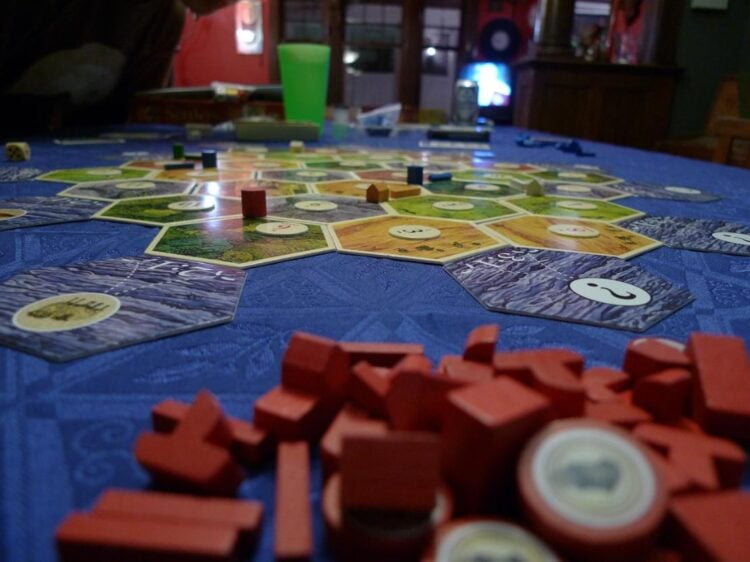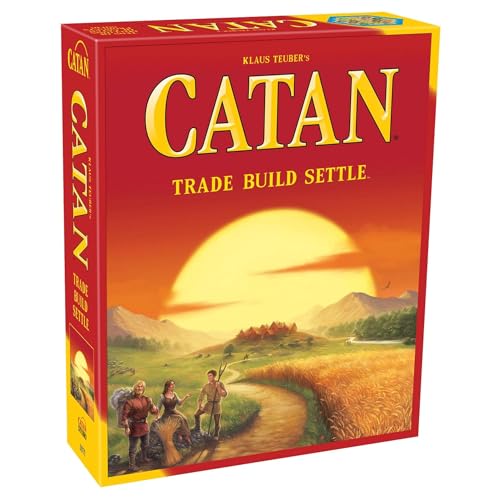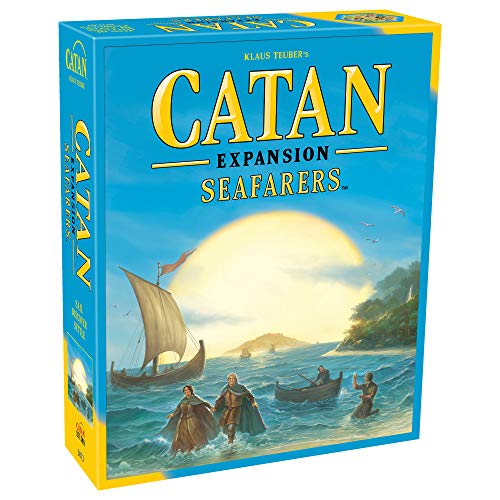
OBJECTIVE OF CATAN: Be the first player to earn 10 Victory Points
NUMBER OF PLAYERS: 2 to 4 players
MATERIALS OF CATAN: Catan game board
TYPE OF GAME: Board game
AUDIENCE: 10+
OVERVIEW OF CATAN
- EXPLORE CATAN: Set sail to the uncharted island of Catan and compete with other...
- RESOURCE MANAGEMENT: Strategically gather and trade resources like ore, brick,...
- BUILD AND UPGRADE: Use your resources to build roads, settlements, and cities to...
Catan is a great game to familiarize yourself with if you’re just getting into the world of board games. Initially, the game was called Settlers of Catan, but now it is simply called Catan. It’s one of my personal favorite board games and is a really fun and quite easy to learn. Once you learn it, I can assure you that you won’t want to stop playing. Let’s go over the rules and strategies for Catan so you can get some friends together and dominate the board.
Just so you know, we’ve included affiliate links in this post – clicking on them supports us without any extra cost to you!
SETUP FOR CATAN
Catan takes an average of an hour to play. Depending on the other player’s knowledge of the game, this can be a bit shorter or longer. You can play with up to four players, but some expansions allow for more. All you need is a Catan game and a flat surface to play on.
WHAT’S IN THE BOX?
You’ll notice all the different game pieces when opening the box. Don’t be intimidated; you will use many of these pieces for the setup. The official Catan game box should include the following:
- 19 unique hexagonal terrain tiles (four pastures, four fields, four forests, three mountains, three hills, and one desert).
- 6 coastal frame pieces
- 9 extra harbor pieces
- 20 wooden settlements(5 of Each Color, look like houses)
- 16 wooden cities (4 of each color, look like churches)
- 60 wooden roads (15 of Each Color, look like bars)
- 95 resource cards (Ore, Grain, Lumber, Wool, and Brick Resources)
- 25 development cards (14 Knight/Soldier Cards, 6 Progress Cards, 5 Victory Point Cards)
- 4 building costs cards
- 2 special bonus cards (Longest Road & Largest Army)
- 18 number tokens
- 2 six-sided dice (one red, one yellow)
- 1 wooden robber pawn
- Simple rules & almanac
You might notice that there is no dedicated board. This is because you are going to build the board yourself.
BOARD SETUP

To get started, you first need to take the six coastal frames and put them together to form a hexagon outline for the rest of the game board.
TILES
Next you need to take the 19 terrain tiles and place them randomly around the inside of the hexagon. They should all fit together snugly. If it is your first time playing, there is a specific setup in the Catan rulebook for beginners. It makes sure the first game is very balanced and ensures no single player will be overly advantaged.
These tiles determine the resource each player receives. If your settlement is touching one of these tiles, you gain a resource from it. The tiles correspond to the following resources:
- Field terrain – Grain
- Forest terrain – Lumbar
- Pasture terrain – Wool
- Mountain terrain – Ore
- Hills terrain – Brick
- Desert terrain – No resource
TOKENS
The next part of the board setup for Catan is the number of tokens. These are the circle tokens with a small letter on one side and a number on the other. Place these in the beginner setup from the rulebook. If you’re not following that setup, then start at one corner and place the tokens in alphabetical order in a spiral shape. Place the A on one tile, then B next to it, and so on, until you reach the board’s center.
Remember to skip the desert tile wherever it is on the board. Instead, place the robber pawn on it. The robber is the small gray bowling pin-looking piece. Once you’ve mastered the game and want to make it more challenging, you can place these tokens randomly around the board.
PLAYER SETUP
Now is when the players come in. Each player can choose the color they want to play, either red, blue, white, or yellow. Each player must also take five settlements, four cities, and 15 road pieces in their own color.
You can then roll the dice to determine which player will go first. Then, the gameplay continues clockwise.
INITIAL SETTLEMENTS
You will place settlements and roads on the board during the game, but to start the game, each player must place two settlements. There is a recommended setup for beginners, so follow it if necessary.
Otherwise, the first player can place one settlement and road anywhere on the board. Then, the next player, in turn, can go. Once each player has gone once, then reverse the turn order for the second placement.
There are a few rules to remember when placing your initial settlements.
- The settlement must be on an intersection where three terrain hexes meet.
- The road must be on one of the intersections connecting to your settlement.
- You cannot place a settlement on an intersection right next to another intersection with an opponent settlement. There must always be enough space for two roads between each settlement.
CARDS
Each player can take a building cost card to remind you what resources you need to build more settlements, cities, and roads. This is just a reference card.
Next, take all the resource cards into their own piles of their type. There are Wool, Lumber, Brick, Ore, and Grain. You can keep these cards next to the board, where they are easily accessible to everyone. Next to these, you can shuffle and place the development cards face down.
Finally, you can place the Longest Road card and the Largest Army card next to the board, along with the dice.
INITIAL RESOURCES

The settlements you place in the game will determine what resources you get. As you know, resources are what will allow you to build more settlements. So, whichever terrain tile your settlement touches is the resource you get.
Before the game begins, each player can take one resource from each tile their second settlement is touching. However, if you are playing the beginner version from the rule book, then you will get the resources for the settlement marked with a white star in the book.
HOW TO PLAY CATAN
Wow, now that was quite a bit of setup, but do not worry. The setup will become second nature once you play a couple of times. Now, let’s go on to the actual gameplay. Each turn in Catan will consist of three parts:
- Producing resources
- Trading
- Building
RESOURCE PRODUCTION
The first part of your turn in Catan is to produce resources. You do this by simply rolling the dice. Easy right? Now, look at the board for the corresponding number, and you can collect a resource from each tile that has that number. Any player that has a resource touching that terrain can also collect that resource. For example, if you rolled a four and there was a number four on a field and a pasture, you get one grain and one wool. If another player’s settlement touches the field that the four were on, they also get to collect one grain for each settlement that touches that terrain.
ROBBER
Remember that robber from earlier that has been waiting in the desert? Well if you happen to roll a seven, then you get to activate the robber. You can move the robber onto any tile on the board. Now that terrain stop producing resources and any player whose settlement is touching that terrain can not collect. The robber keeps robbing until he is moved to another tile.
TRADING

The next part of the game, after you’ve collected all your resources, is trading. Yes this is one of the best aspects of Catan. You can trade your resources with other players. Remember that during your turn you can trade and negotiate with other players, but they can not negotiate and trade with each other, they must wait till their turn.
The second type of trading you can do is called Maritime trading. This doesn’t involve the other players at all. This type of trading lets you trade four of your resources for one another. If you have certain settlements in the game, you can get better deals such as 3:1 or even 2:1!
BUILDING
Alright, this is the last step of your turn and arguably the most important. You have to decide where you want to build your next settlements and roads using the resources you’ve collected.
There’s no limit to how much you can build as long as you have all the required resources and building materials collected. You can build four things in Catan: roads, settlements, cities, or you can buy development cards.
ROADS
Roads are how you expand your territory on the board, allowing you to build more and produce more resources. It costs one brick and one lumber to build one. They go along the edges of the terrain tile, and they must be connected to one of your existing settlements or roads.
Remember that longest road card? You earn it if you’re the first player to build a road that is at least five sections long, not including forks. That card gives you two Victory Points. However, if another player makes a road longer than yours, they can steal the card from you.
SETTLEMENTS

The next thing you can build in Catan is a settlement. It costs one brick, lumber, wool, and grain. Settlements are important because they allow you to collect resources from the terrain tiles. They also connect your roads to each other. Each settlement you build is worth one victory point.
Remember that you can only place a settlement somewhere connected by a road. It must also be two spaces away from any other settlement, even your own.
CITIES
The cities in Catan are the pieces that look like churches. They are more expensive to build than settlements, costing three ore, two grain, and one settlement. You upgrade these the way you do hotels in Monopoly.
Cities are awesome because they are worth two Victory Points and produce two resources of whichever tile they touch. It is definitely worth it to try and upgrade during the game.
DEVELOPMENT CARDS
Finally, the last thing you can do is buy a development card. These cost one wool, one ore, and one grain. They are the luck of the draw, and you can not play the card on the same turn as you draw it.
The development cards will have the instructions written on them. There are three types of cards:
- Knight cards – These allow you to build your army and move the robber once.
- Progress cards – These allow you a reward, such as picking two resources.
- Victory points – These automatically give you a victory point.
END OF GAME
The first player to get 10 victory points is the winner.
CATAN STRATEGY

As you can see, Catan is an extremely strategic game. Every player will have their own way of winning. Here are a few tips and tricks you can use while you come up with your own.
BUILD ON THE DOTS
This is one of the most basic strategies you can use. Simply build your settlements next to the number of tokens with multiple dots. These dots represent the probability of that number being rolled on each turn. The more dots, the higher the probability the more resources you collect.
HOARD
After you’ve played the beginner Catan version, you will likely play the randomized setup. When this happens, you will probably get clumps of resources on the map. If you can build close to these, you have a good chance of hoarding quite a bit of a single resource. This will give you the upper hand later when people desperately need that one resource.
KEEP SCORE
Keeping score in Catan is also extremely important. Due to the secret development cards, you will never know exactly how many points each player has. However, you can get a pretty good estimate by looking at the roads and watching your opponent’s settlements and cities. This will be very important near the end of the game. You will need to decide if it’s better to pursue an opponent close to winning or continue your own strategy.
EXPANSIONS
As you can probably imagine, Catan is a very popular game, and many expansions have been created. Some of them include the following:
Seafarers—This version offers extra sea hexes, and each person gets 15 ships. You explore islands, and many different scenarios are included.
- EXPAND YOUR HORIZONS: Dive into the world of seafaring settlers in CATAN...
- EPIC EXPLORATION: Embark on an epic quest to settle the home island, build...
- UNLEASH ADVENTURE: Discover new seas, new lands, and dynamic gameplay as each...
Cities and Knights—This is similar to the base game but with many more pieces and is much more complex.
- EXPAND YOUR CATAN WORLD: Take your CATAN adventure to new heights with the...
- BECOME A KNIGHT: Protect CATAN from barbarian invasions by becoming a knight and...
- INTRIGUING NEW ELEMENTS: Uncover new gameplay elements, including city...
Traders and Barbarians—This version bundles many different scenarios. For example, there are fish bridges, camel trains, and more.
- EXPAND YOUR CATAN JOURNEY: Enhance your CATAN adventures with the Traders &...
- VERSATILE CUSTOMIZATION: Discover well-tried variants like "Catan Event Cards,"...
- EXPANSION COMPATIBILITY: Independently playable, this expansion can also be...
Besides these, there are also spinoff games such as:
- Settlers of Nuremberg
- The Kids of Catan
- Struggle for Catan
- Catan Junior
- Catan Dice
- Catan Paper& Pencil
- Star Trek Catan
- Ancient Egypt Catan
- Game of Thrones Catan
If you love Catan, check out Carcassonne!
FAQ
How Many People Can Play Catan?
You can play Catan with up to four players. However, some expansions allow for more players.
How Difficult Is Catan?
Catan is relatively easy to learn. While the setup and instructions might seem complicated, they are quite easy to understand.
How Long Does a Game of Catan Take?
An average game of catan can take one to two hours, depending on everyone’s knowledge of the game.
- 20+ Epic Outdoor Drinking Games - June 28, 2024
- 30 Gifts for Board Game Lovers - June 27, 2024
- 33 Games for Church Youth Group - June 21, 2024



